Blog & Latest Updates
Fly Fishing Articles
Insects by Common Name


Insect Order Ephemeroptera (Mayflies)
Taxonomic Navigation -?-
Kingdom
Animalia (Animals)
» Phylum
Arthropoda (Arthropods)
» Class
Insecta (Insects)
» Order Ephemeroptera (Mayflies)
8 families aren't included.
Common Name
| Match | Common Name |
| Mayflies |
This is page 78 of specimens of Ephemeroptera. Visit the main Ephemeroptera page for:
- The behavior and habitat of Ephemeroptera.
- 67 underwater pictures of Ephemeroptera.
Pictures of 828 Mayfly Specimens:
Stenacron (Light Cahills) Mayfly Nymph View 2 Pictures
View 2 Pictures
 View 2 Pictures
View 2 PicturesCollected August 8, 2004 from unknown in Wisconsin
Added to Troutnut.com by Troutnut on January 18, 2006
Added to Troutnut.com by Troutnut on January 18, 2006
Ephemerellidae (Hendricksons, Sulphurs, PMDs, BWOs) Mayfly Nymph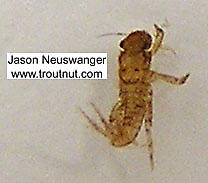 View 3 PicturesThis is a really really really really tiny mayfly nymph. It has gills on abdominal segments 3-7 in the characteristic orientation for the Ephemerellidae family, and it has no fain tail as best I can tell, just uniform tail coverage with small black hairs of equal length. I think this one's too young to identify.
View 3 PicturesThis is a really really really really tiny mayfly nymph. It has gills on abdominal segments 3-7 in the characteristic orientation for the Ephemerellidae family, and it has no fain tail as best I can tell, just uniform tail coverage with small black hairs of equal length. I think this one's too young to identify.
 View 3 PicturesThis is a really really really really tiny mayfly nymph. It has gills on abdominal segments 3-7 in the characteristic orientation for the Ephemerellidae family, and it has no fain tail as best I can tell, just uniform tail coverage with small black hairs of equal length. I think this one's too young to identify.
View 3 PicturesThis is a really really really really tiny mayfly nymph. It has gills on abdominal segments 3-7 in the characteristic orientation for the Ephemerellidae family, and it has no fain tail as best I can tell, just uniform tail coverage with small black hairs of equal length. I think this one's too young to identify.Collected March 10, 2004 from unknown in Wisconsin
Added to Troutnut.com by Troutnut on January 19, 2006
Added to Troutnut.com by Troutnut on January 19, 2006
Female Acerpenna pygmaea (Tiny Blue-Winged Olive) Mayfly Spinner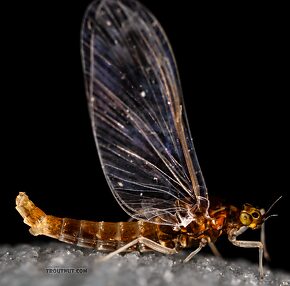 View 3 Pictures
View 3 Pictures
 View 3 Pictures
View 3 PicturesCollected August 1, 2020 from the Henry's Fork of the Snake River in Idaho
Added to Troutnut.com by Troutnut on August 18, 2020
Added to Troutnut.com by Troutnut on August 18, 2020
Male Epeorus albertae (Pink Lady) Mayfly Spinner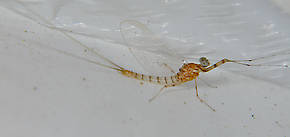 View 2 Pictures
View 2 Pictures
 View 2 Pictures
View 2 PicturesCollected June 29, 2011 from the Touchet River in Washington
Added to Troutnut.com by Bnewell on June 29, 2011
Added to Troutnut.com by Bnewell on June 29, 2011
Epeorus deceptivus Mayfly Nymph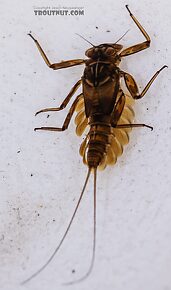 View 4 PicturesIdentification notes from the microscope: Gills on segment 1 extend anteriorly below the body, but not all the way to touching; posterolateral spines minor; femora (
View 4 PicturesIdentification notes from the microscope: Gills on segment 1 extend anteriorly below the body, but not all the way to touching; posterolateral spines minor; femora (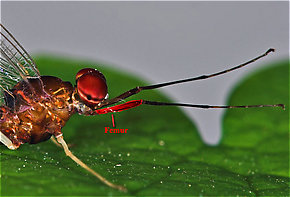 Femur: The main segment of an insect's leg close to the body, in between the tibia and the trochanter.) without fuscous macula.
Femur: The main segment of an insect's leg close to the body, in between the tibia and the trochanter.) without fuscous macula.
 View 4 PicturesIdentification notes from the microscope: Gills on segment 1 extend anteriorly below the body, but not all the way to touching; posterolateral spines minor; femora (
View 4 PicturesIdentification notes from the microscope: Gills on segment 1 extend anteriorly below the body, but not all the way to touching; posterolateral spines minor; femora (
The femur of this Isonychia bicolor mayfly spinner is highlighted in red.
Collected August 4, 2020 from Green Lake Outlet in Idaho
Added to Troutnut.com by Troutnut on August 20, 2020
Added to Troutnut.com by Troutnut on August 20, 2020
Male Rhithrogena robusta Mayfly Spinner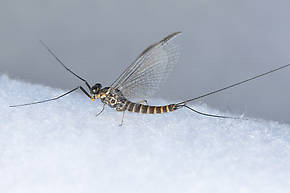 View 3 PicturesThese specimens were collected from a mating swarm from the east branch of the North Fork of the Touchet River, upstream from the Bluewood Ski Area turn.It was a sunny warm day, mating swarm as 4-8 ft. above this small stream. Four male spinners were collected.Stream photos were taken.
View 3 PicturesThese specimens were collected from a mating swarm from the east branch of the North Fork of the Touchet River, upstream from the Bluewood Ski Area turn.It was a sunny warm day, mating swarm as 4-8 ft. above this small stream. Four male spinners were collected.Stream photos were taken.
 View 3 PicturesThese specimens were collected from a mating swarm from the east branch of the North Fork of the Touchet River, upstream from the Bluewood Ski Area turn.It was a sunny warm day, mating swarm as 4-8 ft. above this small stream. Four male spinners were collected.Stream photos were taken.
View 3 PicturesThese specimens were collected from a mating swarm from the east branch of the North Fork of the Touchet River, upstream from the Bluewood Ski Area turn.It was a sunny warm day, mating swarm as 4-8 ft. above this small stream. Four male spinners were collected.Stream photos were taken.Collected July 15, 2011 from the Touchet River in Washington
Added to Troutnut.com by Bnewell on July 15, 2011
Added to Troutnut.com by Bnewell on July 15, 2011
Maccaffertium terminatum Mayfly Nymph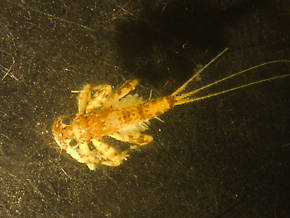 View 1 PicturesThis is a subspecies (Subspecies: Entomologists sometimes further divide a species into distinct groups called subspecies, which have two lower-case words on the end of their scientific name instead of one. The latter is the sub-species name. For example, Maccaffertium mexicanum mexicanum and Maccaffertium mexicanum integrum are two different subspecies of Maccaffertium mexicanum.) M. terminatum terminatum, formerly called Stenonema. Found mostly in larger rivers in western Montana. This is an immature nymph.
View 1 PicturesThis is a subspecies (Subspecies: Entomologists sometimes further divide a species into distinct groups called subspecies, which have two lower-case words on the end of their scientific name instead of one. The latter is the sub-species name. For example, Maccaffertium mexicanum mexicanum and Maccaffertium mexicanum integrum are two different subspecies of Maccaffertium mexicanum.) M. terminatum terminatum, formerly called Stenonema. Found mostly in larger rivers in western Montana. This is an immature nymph.
 View 1 PicturesThis is a subspecies (Subspecies: Entomologists sometimes further divide a species into distinct groups called subspecies, which have two lower-case words on the end of their scientific name instead of one. The latter is the sub-species name. For example, Maccaffertium mexicanum mexicanum and Maccaffertium mexicanum integrum are two different subspecies of Maccaffertium mexicanum.) M. terminatum terminatum, formerly called Stenonema. Found mostly in larger rivers in western Montana. This is an immature nymph.
View 1 PicturesThis is a subspecies (Subspecies: Entomologists sometimes further divide a species into distinct groups called subspecies, which have two lower-case words on the end of their scientific name instead of one. The latter is the sub-species name. For example, Maccaffertium mexicanum mexicanum and Maccaffertium mexicanum integrum are two different subspecies of Maccaffertium mexicanum.) M. terminatum terminatum, formerly called Stenonema. Found mostly in larger rivers in western Montana. This is an immature nymph.Collected November 23, 2005 from the Flathead River-lower in Montana
Added to Troutnut.com by Bnewell on June 26, 2011
Added to Troutnut.com by Bnewell on June 26, 2011
Female Baetis tricaudatus (Blue-Winged Olive) Mayfly Spinner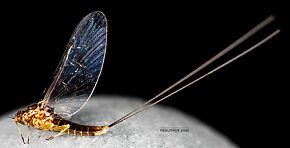 View 5 PicturesThis female spinner was deceased when photographed, so the posture is unnatural, but it was a substantial hatch and clearly worth imitating (with wet flies to imitate the sunken ovipositing females) so I went ahead with the photos.
View 5 PicturesThis female spinner was deceased when photographed, so the posture is unnatural, but it was a substantial hatch and clearly worth imitating (with wet flies to imitate the sunken ovipositing females) so I went ahead with the photos.
It was collected in association with a male spinner.
 View 5 PicturesThis female spinner was deceased when photographed, so the posture is unnatural, but it was a substantial hatch and clearly worth imitating (with wet flies to imitate the sunken ovipositing females) so I went ahead with the photos.
View 5 PicturesThis female spinner was deceased when photographed, so the posture is unnatural, but it was a substantial hatch and clearly worth imitating (with wet flies to imitate the sunken ovipositing females) so I went ahead with the photos.It was collected in association with a male spinner.
Collected September 4, 2020 from Silver Creek in Idaho
Added to Troutnut.com by Troutnut on September 18, 2020
Added to Troutnut.com by Troutnut on September 18, 2020
Male Tricorythodes (Tricos) Mayfly Spinner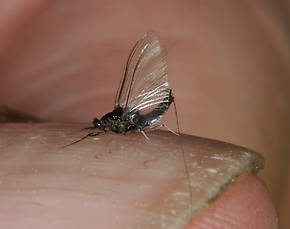 View 3 PicturesI collected these males about 9:30 AM, air temp. about 68 degrees F. The males were flying about 3 ft above the stream flying up and down the stream rather than the typical vertical swarm you see with most mayfly males. The males are black and the females are a green color due to the eggs they are carrying. They do not live very long which is typical for small bodied mayflies. They do not fly during windy conditions. I suspect these are Tricorythodes minutus.
View 3 PicturesI collected these males about 9:30 AM, air temp. about 68 degrees F. The males were flying about 3 ft above the stream flying up and down the stream rather than the typical vertical swarm you see with most mayfly males. The males are black and the females are a green color due to the eggs they are carrying. They do not live very long which is typical for small bodied mayflies. They do not fly during windy conditions. I suspect these are Tricorythodes minutus.
 View 3 PicturesI collected these males about 9:30 AM, air temp. about 68 degrees F. The males were flying about 3 ft above the stream flying up and down the stream rather than the typical vertical swarm you see with most mayfly males. The males are black and the females are a green color due to the eggs they are carrying. They do not live very long which is typical for small bodied mayflies. They do not fly during windy conditions. I suspect these are Tricorythodes minutus.
View 3 PicturesI collected these males about 9:30 AM, air temp. about 68 degrees F. The males were flying about 3 ft above the stream flying up and down the stream rather than the typical vertical swarm you see with most mayfly males. The males are black and the females are a green color due to the eggs they are carrying. They do not live very long which is typical for small bodied mayflies. They do not fly during windy conditions. I suspect these are Tricorythodes minutus.Collected August 12, 2011 from the Touchet River in Washington
Added to Troutnut.com by Bnewell on August 12, 2011
Added to Troutnut.com by Bnewell on August 12, 2011
Attenella margarita (Little Western Blue-Winged Olive) Mayfly Nymph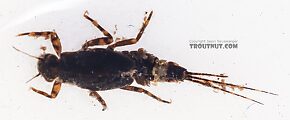 View 7 PicturesNotes from the microscope on the ID: Maxillary palp (
View 7 PicturesNotes from the microscope on the ID: Maxillary palp (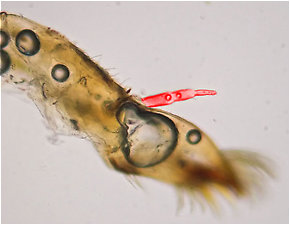 Palp: A long, thin, often segmented appendage which can protrude from certain insect mouth parts such as the maxillae. Also known as the < />palpus.) is present, distinctly 2-segmented, but very small. Gills on segment 4-7. This specimen has some unfortunate damage to the abdomen, but it's the only one I found in my sample.
Palp: A long, thin, often segmented appendage which can protrude from certain insect mouth parts such as the maxillae. Also known as the < />palpus.) is present, distinctly 2-segmented, but very small. Gills on segment 4-7. This specimen has some unfortunate damage to the abdomen, but it's the only one I found in my sample.
 View 7 PicturesNotes from the microscope on the ID: Maxillary palp (
View 7 PicturesNotes from the microscope on the ID: Maxillary palp (
The palp on the maxilla of an Ephemerella nymph (detached and photographed under a microscope) is highlighted in red here.
Collected August 3, 2020 from the East Fork Big Lost River in Idaho
Added to Troutnut.com by Troutnut on August 19, 2020
Added to Troutnut.com by Troutnut on August 19, 2020
Top 10 Fly Hatches
Top Gift Shop Designs
Eat mayflies.
Top Insect Specimens
Miscellaneous Sites
Troutnut.com is copyright © 2004-2024 Jason
Neuswanger (email Jason). See my FAQ for information about use of my images.
 privacy policy
privacy policy
